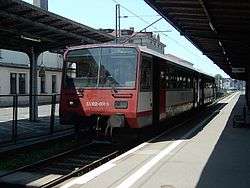Class 207M
Class 207M is a prototype series of Polish light Diesel Multiple Units (a.k.a. railcars). Only six were made in following configurations:
- two cars - a set of 207M power car and 207Mr trailer-control car (PKP designation SA101+SA121)
- three cars - a set of: 207Ma power car, 207Mra trailer car, 207Mb power car (PKP designation SA102+SA111+SA102)

History
By the end of the 1970s, steam traction in Poland was mostly retired. Non-electrified lines became operated with diesel locomotives. For short distance passenger traffic (mainly suburban trains) PKP was seeking a more economical solution than a heavy diesel locomotive pulling few cars. The obvious solution was the use of railcars. However, due to politics-related economical problems Poland was facing in 1980s, it wasn't until 1990 that the first cars were produced.
The class 207M was developed in ZNTK Poznań by a team led by Polish renowned rail transport engineer Ryszard Suwalski. The concept prospected trains from one up to four cars in consist. Only 2- and 3-car versions were made, three of each. Again, due to economical difficulties class 207M never went into serious production. After 2001 a larger contingent of railcars/DMUs went into production and they were based on newer projects than 207M.
Technical data
| 207M | 207Mr | 207Ma | 207Mb | 207Mra | |
|---|---|---|---|---|---|
| PKP designation | SA101 | SA121 | SA102 (A) | SA102 (B) | SA111 |
| year of production | 1990–1992 | 1993–1996 | |||
| motor type | Deutz BF6L513RC
200 kW |
— | Deutz BF6L513RC
200 kW |
— | |
| axle configuration | 1'A | 1'1' | 1'A | 1'1' | |
| maximum speed | 90 km/h | ||||
| Wikimedia Commons has media related to ZNTK Poznań 207M. |